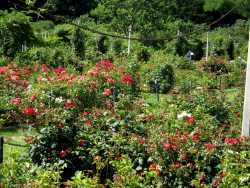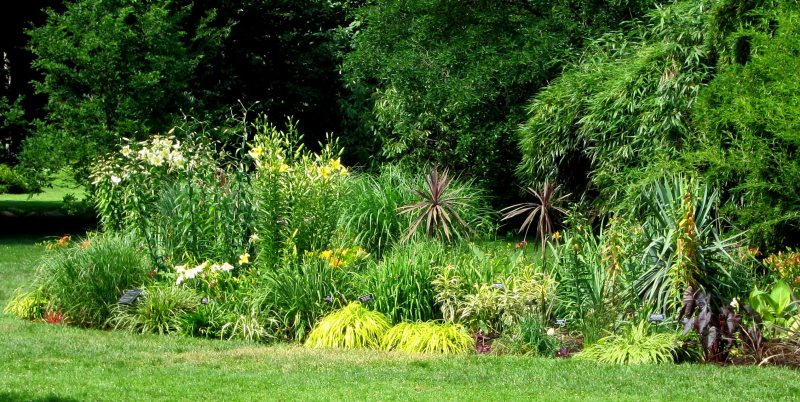BBG

|
Brooklyn Botanic Garden
Off we went on the subway to see the Brooklyn Botanic Garden (BBG) in the borough of Brooklyn in New York City; it's in the “1000 things to do” book which was enough to get us on the bus and subway to visit. Located near the Prospect Heights, Crown Heights and Park Slope neighbourhoods, the 52-acre garden includes a number of specialty "gardens within the Garden," plant collections, and the Steinhardt Conservatory, which houses the C.V. Starr Bonsai Museum, three climate-themed plant pavilions, a white cast-iron and glass aquatic plant house, and an art gallery. Founded in 1910, the Garden holds over 10,000 taxa of plants and each year welcomes over 900,000 visitors from around the world.
The Japanese Hill-and-Pond Garden: BBG's Japanese Hill-and-Pond Garden was the first Japanese garden to be created in an American public garden. It was constructed in 1914 and 1915 at a cost of $13,000, a gift of early BBG benefactor and trustee Alfred T. White, and it first opened to the public in June 1915. Widely considered by numerous landscape architects, to be the masterpiece of its creator, Japanese landscape designer Takeo Shiota (1881 - 1943). Shiota was born in a small Japanese village about 40 miles from Tokyo, and in his youth spent years traversing Japan on foot to explore its natural landscape. He emigrated to the United States in 1907.
The Bonsai Collection
Cherry Trees: The Garden has more than 200 cherry trees of forty-two Asian species and cultivated varieties, making it one of the foremost cherry-viewing sites outside of Japan. The first cherries were planted at the garden after World War I, a gift from the Japanese government. Each spring at BBG, when the trees are in bloom, a month-long cherry blossom viewing festival called Hanami is held, culminating in a weekend celebration called Sakura Matsuri. Cherry trees are found on the Cherry Esplanade and Cherry Walk, in the Japanese Hill-and-Pond Garden, and in many other locations in the Garden. Depending on weather conditions, the Asian flowering cherries bloom from late March or early April to mid-May. The many different species bloom at slightly different times, and the sequence is tracked online at Cherry Watch, on the BBG website. The garden is a blend of the ancient hill-and-pond style and the more modern stroll-garden style, in which various landscape features are gradually revealed along winding paths. Its 3 acres contain hills, a waterfall, a pond, and an island, all artificially constructed. Carefully placed rocks also play leading roles. Among the architectural elements of the garden are wooden bridges, stone lanterns, a viewing pavilion, a torii or gateway, and a Shinto shrine. A restoration of the garden in 2000 was recognized with the New York Landmark Conservancy's 2001 Preservation Award.
The Cranford Rose Garden: In 1927, Walter V. Cranford, a construction engineer whose firm built many of Brooklyn's subway tunnels, donated $15,000 to BBG for a rose garden. Excavation revealed an old cobblestone road two feet below the surface and tons of glacial rock, which had to be carted away on horse-drawn barges. The Cranford Rose Garden opened in June 1928. It was designed by Harold Caparn, a landscape architect, and Montague Free, the Garden's horticulturist. Many of the original plants are still in the garden today. There are over 5,000 bushes of nearly 1,400 kinds of roses, including wild species, old garden roses, hybrid tea roses, grandifloras, floribundas, polyanthas, hybrid perpetuals, climbers, ramblers, and miniature roses.
The Shakespeare Garden: A donation from Henry C. Folger, founder of the Folger Shakespeare Library in Washington, D.C. paved the way for the construction of BBG's original Shakespeare Garden in 1925. Since moved to a different location in the Garden, this English cottage garden exhibits more than 80 plants mentioned in William Shakespeare's plays and poems. Plant labels give the plants' common or Shakespearean names, their botanical names, relevant quotations, and, in some cases, a graphic representation of the plant.
The Alice Recknagel Ireys Fragrance Garden: Next to the Shakespeare Garden is the Fragrance Garden, complete with braille information signs for visitors with vision disabilities. Created in 1955 by landscape architect Alice Recknagel Ireys, this was the first garden in the country designed for the vision-impaired. All visitors are encouraged to rub the fragrant or pleasingly textured leaves of the plants between their fingers. There are four sections in the garden, each with a theme: plants to touch, plants with scented leaves, plants with fragrant flowers, and kitchen herbs. The garden is wheelchair-accessible, and all planting beds are at an appropriate height for people in wheelchairs. A fountain provides a calming sound and a place to wash one's hands after touching the various plants.
The Children's Garden: The BBG Children's Garden is the oldest continually operating children's garden within a botanic garden in the world. It was opened in 1914 under the direction of BBG educator Ellen Eddy Shaw and operates as a community garden for children, with hundreds of children registering each year for plots on the 1-acre site. The BBG Children's Garden has served as a model for similar gardens around the world.
Other gardens: the Discovery Garden, designed for young children; the Herb Garden; the Lily Pool Terrace, which includes two large display pools and annual and perennial borders; the Native Flora garden, the first of its kind in North America; the Osborne Garden, a 3-acre, Italian-style garden, and the Rock Garden, built around 18 boulders left behind by the glacier during the Ice Age. A Celebrity Path honors famous Brooklynites past and present, such as Barbra Streisand, Woody Allen, and Walt Whitman, with a trail of engraved paving stones.
The Plant Family Collection, which takes about a third of BBG's total area, includes plants and trees arranged by family to show their evolutionary progression from most primitive to most recently evolved. Although recent studies of plant genetics have changed classification of individual plants, the groupings are still an excellent introduction to the many different plant families and their constituent species.
The Steinhardt Conservatory houses BBG's extensive indoor plant collection in three climate-controlled pavilions for tropical, warm temperate, and desert floras. Also located here are: the C.V. Starr Bonsai Museum, one of the oldest collections of dwarfed, potted trees in the country; an art gallery for changing art exhibitions; the Robert W. Wilson Aquatic House, with its collections of tropical water plants, insect-eating plants, and orchids; and the Stephen K-M. Tim Trail of Evolution, which traces the history of plant evolution and the effects of climate change over 3½ billion years.
BBG has about 165 full-time and 90 part-time employees along with 600 volunteers. Its annual operating budget is $16.2 million.
ALL IN ALL A LOVELY PLACE TO
AMBLE |
























